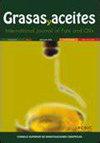非靶向脂质组学方法,使用LC-Orbitrap HRMS区分猪油、牛油和鸡脂肪,用于清真认证
IF 1.1
4区 农林科学
Q4 CHEMISTRY, APPLIED
引用次数: 0
摘要
本研究旨在采用液相色谱-高分辨率质谱(LC-HRMS)技术对猪油、牛油和鸡脂肪进行脂质组学鉴定。在猪油、牛脂和鸡脂中分别检测到292、345和403种脂质化合物。发现猪油特异性的脂质基团为AcHexStE(酰基己糖基豆甾醇酯)、biotinylPE(生物素基磷酸乙醇胺)、LPC(溶血磷脂酰胆碱)、MePC(单醚磷脂酰胆碱)、PC(磷脂酰胆碱)和PI(磷酸菌醇)。主成分分析(PCA)和偏最小二乘判别分析(PLS-DA)成功地将猪油与牛脂和鸡脂区分开来。本研究表明,LC-HRMS结合化学计量学的非靶向脂质组学技术可用于猪油、牛脂和鸡脂的鉴别。该方法是一种很有前途的技术检测猪油掺假牛油和鸡脂肪的清真认证目的。本文章由计算机程序翻译,如有差异,请以英文原文为准。
Untargeted lipidomics approach using LC-Orbitrap HRMS to discriminate lard from beef tallow and chicken fat for the authentification of halal
This research aimed to perform a lipidomics study using liquid chromatography-high resolution mass spectrometry (LC-HRMS) to identify lard, beef tallow and chicken fat. A total of 292, 345, and 403 lipid compounds were observed in lard, beef tallow, and chicken fat, respectively. The lipid groups of AcHexStE (acyl hexosyl stigmasterol ester), biotinylPE (biotinylphosphoetanolamine), LPC (lysophosphatidylcholine), MePC (monoetherphosphatidylcholine), PC (phosphatidylcholine) and PI (phosphoinocitol) were found to be specific for lard. The principal component analysis (PCA) and partial least square-discriminant analysis (PLS-DA) successfully differentiated lard from beef tallow and chicken fat. This research suggested that the untargeted lipidomics technique using LC-HRMS combined with chemometrics could be used to discriminate lard from beef tallow and chicken fat. This method is a promising technique for the detection of lard adulteration in beef tallow and chicken fat for halal authentication purposes.
求助全文
通过发布文献求助,成功后即可免费获取论文全文。
去求助
来源期刊

Grasas y Aceites
工程技术-食品科技
CiteScore
2.50
自引率
0.00%
发文量
50
审稿时长
3 months
期刊介绍:
Grasas y Aceites is a peer-reviewed journal devoted to the publication of original articles concerning the broad field of lipids, especially edible fats and oils from different origins, including non acyl lipids from microbial origin relevant to the food industry. It publishes full research articles, research notes, reviews as well as information on references, patents, and books.
Grasas y Aceites publishes original articles on basic or practical research, as well as review articles on lipid related topics in food science and technology, biology, (bio)chemistry, medical science, nutrition, (bio)technology, processing and engineering. Topics at the interface of basic research and applications are encouraged. Manuscripts related to by-products from the oil industry and the handling and treatment of the wastewaters are also welcomed.
Topics of special interest to Grasas y Aceites are:
-Lipid analysis, including sensory analysis
-Oleochemistry, including lipase modified lipids
-Biochemistry and molecular biology of lipids, including genetically modified oil crops and micro-organisms
-Lipids in health and disease, including functional foods and clinical studies
-Technical aspects of oil extraction and refining
-Processing and storage of oleaginous fruit, especially olive pickling
-Agricultural practices in oil crops, when affecting oil yield or quality
 求助内容:
求助内容: 应助结果提醒方式:
应助结果提醒方式:


